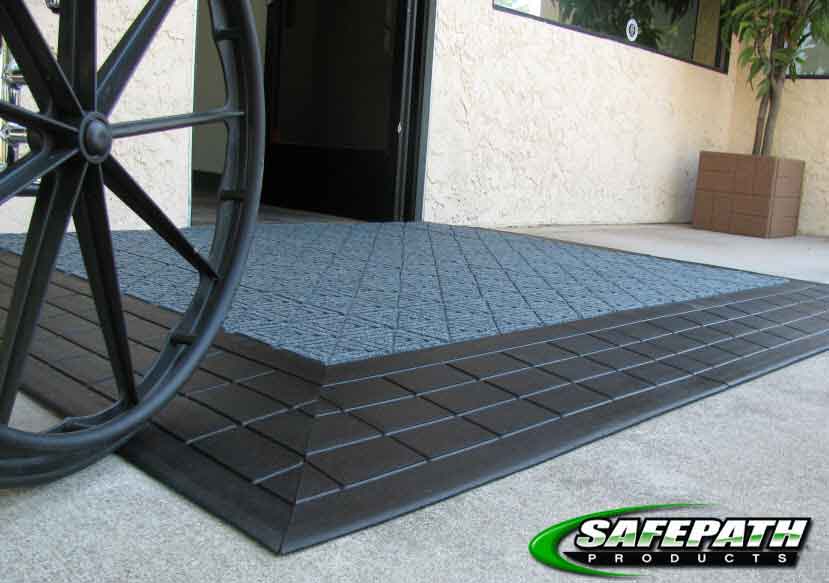Removal of DHI Complex Barriers
The goal is to afford every individual the opportunity to benefit from our country’s businesses and services, and to afford our businesses and services the opportunity to benefit from the patronage of all Americans. To do so, access must be provided to entryways on the path of travel from the parking lot into facilities and rooms where your products and services are provided.
A good starting point is to make improvements to the location in your facility that provides the greatest degree of access for most people. Following this concept is helpful in prioritizing and providing a starting point for barrier removal.
Facility owners and managers are often then faced with the dilemma of having to modify buildings, sometimes of antiquated architectural design, under the sometimes conflicting, or at least confusing, statutory language of the ADA. Local and state building codes, some of which are in concert with the ADA and some of which are not, must also be considered when deciding the most appropriate ways to remove barriers.
Fortunately, the adoption of the 2010 ADA Standards for Accessible Design (2010 ADAS) – which took effect throughout the United States in March 2012 – provided many clarifications and improvements to the regulations. This was the first major update to the 1990 ADA Standards, and many states followed suit.
In it the ADA distinguishes between the standards of compliance for new construction, additions and simple barrier removal for existing facilities. New construction must incorporate accessibility by design, construction methods and products used. Unfortunately, mistakes are made, and retrofit accessibility products can sometimes provide solutions. Altered facilities must also comply with new construction standards to the maximum extent feasible, and retrofit products are frequently used. All newly constructed or altered areas of facilities, either commercial or public, must be made accessible.
When the alteration goes beyond simple barrier removal and involves remodeling or renovation, different rules for barrier removal apply. Depending upon the extent of the alteration and the functional area modified and the usability of that area, different standards or burdens, to the extent of accessibility modifications required, may be placed on the building’s owner. For existing facilities, the ADA “requires the removal of architectural barriers…that are structural in nature…where such removal is readily achievable, i.e., easily accomplishable, and able to be carried out without much difficulty or expense.”
This brings us to one of the more difficult problems presented by existing buildings: door thresholds that are too high to comply with the 2010 ADA standards. Everyone agrees that threshold height can be a significant barrier to someone in a wheelchair or with another form of disability, but removing that barrier can be very difficult. A common and cost-effective solution is the construction of an ADA level landing or using a ramp with a maximum slope of 1:12 (one inch of vertical rise for every 12 inches of horizontal length). https://arroyoroom.com/products/
Very simply, it is desirable for a person in a wheelchair to be on a level surface when opening a door, or to be able to manage a wheelchair on a slope that is not too steep. Fortunately, the height of most thresholds that are out of compliance allow for modular level landing systems which can maintain existing slope and allow a person in a wheelchair to approach and open a door on a level maneuverable surface area. In these instances, it’s important to specify the side approach to these landings and be mindful that the cross slope be no greater than 2%. Interpreting the 2010 ADA while considering local building codes is not always easy and often demands interpretation, especially when you are trying to determine the best alternative to a difficult situation.
Clearly, the major impact of the ADA is on existing facilities. As stated in 2010 ADAS Section 202.3.1 Prohibited Reduction in Access: An alteration that decreases or has the effect of decreasing the accessibility of a building or facility below the requirements for new construction at the time of the alteration is prohibited. Although the ADA encourages “readily achievable” solutions to existing problems, once alterations for barrier removal has been initiated, all work must comply with the 2010 ADAS as for new construction and cannot be a reduction of access.
This was not as clear under the 1991 ADAS. 2010 ADAS Section 404.2.5 requires all thresholds at doors to be a ½” high maximum. Thresholds between a ¼” and a ½” shall be beveled with a slope not steeper than 1:2. Thresholds that do not exceed a ¼” high maximum may be vertical. Existing or altered thresholds ¾” high maximum that have a beveled edge on each threshold side with a slope not steeper than 1:2 are not required to comply.
Therefore, best practices suggest that if your building was constructed before 1991 and a threshold is out of compliance, and is 3/4” or less in height, and there is no other modernization or construction going on, then a modest threshold ramp would act as a ”readily achievable” accommodation. However, in every other instance, a level landing at the door threshold would be required for threshold modification.
On the commercial side, logic and building requirements of the past often conflict with regulations of the present. For example, facility owners are often faced with the problem of having many door thresholds of ¾” or greater, which do not meet with the 2010 ADAS requirements.
Gene McFarren, an architect in Chico, CA, points out that, “In the past, because of problems with water and moisture penetrating framing, many commercial building doorways were constructed with rises in thresholds to prevent water damage”. He continued, “On-grade concrete floor slab systems in the 1967 Uniform Building Code required exterior lath extensions to extend below the floor line, which was before the advent of high-grade sealants.”
Deciding to ramp or construct a level-landing at existing thresholds can become confusing when considering Section 404.2.4.1, Maneuvering Clearances at Manual Swinging Doors and Gates, which requires that there be a level landing area for hinge side and latch side swing door approaches. Essentially, landing areas in front of door thresholds must be level, a requirement which seems to conflict with desirability of using modular ramping systems as a practical solution to an access problem.
The “readily achievable” standard, however, encourages some reasonable solutions to the problem that benefit the disabled person and the facility owner. Ken Manrubia, a commercial door and hardware specialist for DLR Sales in California, states,
“The choice for customers is to either build up the concrete around the building or put in a modular ramp system. If one is using a ramp system, he should consider not only product cost but also installation method and cost.”
Modifications can be made using expensive traditional methods of saw cutting and reforming cement. Or, as thousands of businesses have found, there are a multitude of less costly alternative solutions for level-landing products with transitions on front and side approaches. Concrete, pre-fabricated aluminum, and rubber matting landing systems are the usual options, with aluminum and concrete being the most expensive to purchase and install. A rubber level landing and ramping system has the advantage of being easily cut to fit in the field and can be attached with adhesives or other fastening devices.
The door and hardware industry will increasingly be called upon to provide accessibility products and solutions to large and small businesses and public entities. With the growing Baby Boomer generation reaching retirement age, this will continue to demand full inclusion in the social and economic fabric of our country, and it behooves providers of products and builders to familiarize themselves as much as possible with the ADA requirements.
Most importantly, design officials, code enforcement officials, contractors, product suppliers and the disabled community must continue the dialogue to determine affordable and acceptable products for compliance purposes.
TIMOTHY VANDER HEIDEN, J.D., is CEO of SafePath Products and Van Duerr Industries, Inc. He has more than 28 years of experience marketing and manufacturing products for ADA compliance, specializing in green technology for the architectural marketplace. Tim and his team can be reached at 800.497.2003, or visit www.safepathproducts.com.

